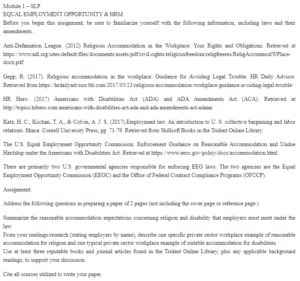Equal Employment Opportunity and HRM
Religious Accommodations
Navigating Religious differences is one of the critical human resource aspects that employers must address. Employees encounter a myriad of conflicts resulting from religious and workplace obligations. As a result, labor laws require employers to accommodate employees’ religious commitments. For instance, Title VII of the Civil Rights Act of 1964 requires employees to accommodate their employees’ religious obligations unless such a move will significantly compromise a business’s operations (Office of Civil Rights, 2020).
Religious accommodations vary depending on the employees’ requirements. They include a day off weekly (Sabbath), a day off annually for a religious holiday, wearing religious clothing like hijab, and allocation of a worshipping place at the workplace (Sampurna, 2019). Employers employ different strategies to ensure that such accommodations do not adversely impact productivity at the workplace. Flexible scheduling, employee shift swaps, task substitution, and lateral transfers enable employers to accommodate their workers’ religious needs.
For instance, someone who observes Friday as their Sabbath can work longer on Monday through to Thursday. That way, they can take leave on Friday without necessarily hurting productivity at the workplace. Another workable strategy is allowing employees to work on paid leave days to take days off later to attend to their religious obligations.
Other religious accommodations are based on dressing and grooming. Whereas Muslims may require their employers to accommodate their dress code, such as hijab, Christians may need to incorporate crosses in their sauce. Also, hair length, the length of pants, and women not wearing pants, among other needs, ought to be accommodated by employers.
Disability Accommodations
The American Disabilities Act (ADA) applies to employers with more than 15 employees and addresses discrimination against disabled employees in the workplace. Mainly, Title I of the ADA provides non-discrimination against a disabled employee unless such accommodation imposes an undue hardship on a business’s operations (U.S. Equal Employment Opportunity Commission, 2002). The provision applies to private employers, states, and local governments. The law is applicable only if an employee in question is qualified for the positions they hold.
Some of the provision requirements include the modification of a job application process to accommodate a disabled person as long as they are qualified. For instance, if an employee is disabled and cannot present themselves to the workplace on the interviewing day, the company can use video conferencing for a similar purpose (Gignac et al., 2020).
Another disability accommodation is modifying the workplace environment to enable a qualified but disabled person to work. For instance, if the building hosting offices is a skyscraper, the employer should install walkways on top of stairs to facilitate movement for the disabled (U.S. Equal Employment Opportunity Commission, 2002). Finally, the requirement allows employers to ensure people with disabilities get the same benefits as people without disabilities.
Examples of Companies with Religious and Disability Accommodations
One of the successful disability-accommodating companies is Bloomberg. The company employs an empathy and innovation policy when hiring employees. Bloomberg enhances employability access by partnering with tech-based companies such as Lime Connect. To bolster the internal acceptance of disabled members, the company recently launched Beyond Our Sight, a program intended to help non-disabled members experience what the blind experience. Such programs attract disabled employees to the company.
On the other hand, Google ranks highly regarding religious inclusion. Such inclusion mainly borders on the accommodation of religious holidays. The company allows its employees to substitute and reschedule tasks as long as that does not cause hardship in its operations, among other issues.
References
Gignac, M. A. M., Bowring, J., Jetha, A., Beaton, D. E., Breslin, F. C., Franche, R.-L., Irvin, E., Macdermid, J. C., Shaw, W. S., Smith, P. M., Thompson, A., Tompa, E., Van Eerd, D., & Saunders, R. (2020). Disclosure, Privacy and Workplace Accommodation of Episodic Disabilities: Organizational Perspectives on Disability Communication-Support Processes to Sustain Employment. Journal of Occupational Rehabilitation, 31(1), 153–165. https://doi.org/10.1007/s10926-020-09901-2
Office of Civil Rights. (2020, March 6). Disability and Religious Accommodations. Www.doi.gov. https://www.doi.gov/pmb/eeo/disability-and-religious-accommodations
Sampurna, R. H. (2019). Accommodating Religious Practices in the Workplace: The Case of Indonesian Workers in Taiwan. Society, 7(2), 159–172. https://doi.org/10.33019/society.v7i2.93
U.S. Equal Employment Opportunity Commission. (2002, October 17). Enforcement Guidance on Reasonable Accommodation and Undue Hardship under the ADA | U.S. Equal Employment Opportunity Commission. Www.eeoc.gov. https://www.eeoc.gov/laws/guidance/enforcement-guidance-reasonable-accommodation-and-undue-hardship-under-ada
ORDER A PLAGIARISM-FREE PAPER HERE
We’ll write everything from scratch
Question

Equal Employment Opportunity and HRM
Module 1 – SLP
EQUAL EMPLOYMENT OPPORTUNITY & HRM
Before you begin this assignment, be sure to familiarize yourself with the following information, including laws and their amendments.
Anti-Defamation League. (2012) Religious Accommodation in the Workplace: Your Rights and Obligations. Retrieved at https://www.adl.org/sites/default/files/documents/assets/pdf/civil-rights/religiousfreedom/religfreeres/ReligAccommodWPlace-docx.pdf
Gepp, R. (2017). Religious accommodation in the workplace: Guidance for Avoiding Legal Trouble. HR Daily Advisor. Retrieved from https://hrdailyadvisor.blr.com/2017/05/23/religious-accommodation-workplace-guidance-avoiding-legal-trouble/
HR Hero. (2017) Americans with Disabilities Act (ADA) and ADA Amendments Act (ACA). Retrieved at http://topics.hrhero.com/americans-with-disabilities-act-ada-and-ada-amendments-act-adaaa/
Katz, H. C., Kochan, T. A., & Colvin, A. J. S. (2017).Employment law. An introduction to U. S. collective bargaining and labor relations. Ithaca: Cornell University Press, pg. 71-79. Retrieved from Skillsoft Books in the Trident Online Library.
The U.S. Equal Employment Opportunity Commission. Enforcement Guidance on Reasonable Accommodation and Undue Hardship under the Americans with Disabilities Act. Retrieved at https://www.eeoc.gov/policy/docs/accommodation.html
There are primarily two U.S. governmental agencies responsible for enforcing EEO laws. The two agencies are the Equal Employment Opportunity Commission (EEOC) and the Office of Federal Contract Compliance Programs (OFCCP).
Assignment:
Address the following questions in preparing a paper of 2 pages (not including the cover page or reference page.)
Summarize the reasonable accommodation expectations concerning religion and disability that employers must meet under the law.
From your readings/research (stating employers by name), describe one specific private sector workplace example of reasonable accommodation for religion and one typical private sector workplace example of suitable accommodation for disabilities.
Use at least three reputable books and journal articles found in the Trident Online Library, plus any applicable background readings, to support your discussion.
Cite all sources utilized to write your paper.

